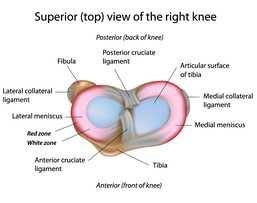

What are Collateral Ligaments?
Knee ligaments connect the lower leg bones (tibia and fibula) to the thigh bone (femur). The knee is vital to movement and is the largest joint in the body. The collateral ligament on the inside of the knee (medial) connects the femur to the tibia. The ligament on the outside of the knee (lateral) connects the femur to the fibula.
 Bones are connected to other bones by ligaments. There are four primary ligaments in your knee. They act like strong ropes to hold the bones together and keep your knee stable. The knee is made up of cruciate (ACL and PCL) and collateral ligaments that all work together to help stabilize the joint. The cruciate ligaments control the back and forth motion of the knee. The cruciate ligaments cross each other to form an “X” to and from the front and back of the knee. Collateral ligaments are found on the sides of the knee. They control the sideways motion of the knee.
Bones are connected to other bones by ligaments. There are four primary ligaments in your knee. They act like strong ropes to hold the bones together and keep your knee stable. The knee is made up of cruciate (ACL and PCL) and collateral ligaments that all work together to help stabilize the joint. The cruciate ligaments control the back and forth motion of the knee. The cruciate ligaments cross each other to form an “X” to and from the front and back of the knee. Collateral ligaments are found on the sides of the knee. They control the sideways motion of the knee.
What is a Collateral Ligament Injury?
The collateral ligaments are commonly injured parts of the knee. There are different grades of injury to these ligaments. Sometimes an injury may be described as a strain, which is overstretching the ligament without tearing it. The ligament may also be completely torn.
What are Common Causes?
An injury to these ligaments usually involves a significant force, such as a fall while skiing, playing a sport, or a direct impact to the side of the leg.
Diagnosis and Examination
To receive a diagnosis, a qualified musculoskeletal expert will first take a medical history and conduct a physical exam. A physician will compare a patient’s non injured knee with the injured knee. Most injured ligaments can be diagnosed after examination. Imaging tests such as MRI or x-rays may be needed to see if there are additional injuries such as broken bones or other soft tissue injuries (muscle, tendons, ligaments, and cartilage).
Treatment
Most collateral ligament injuries can be treated without surgery, especially if the injury is considered a strain. A completely torn ligament will likely require surgery. Physical therapy will be a very important part of your recovery. A physical therapist will guide you in many stretches and exercises to help you restore your range of motion, strength and stability.
Copyright © www.orthopaedics.win Bone Health All Rights Reserved